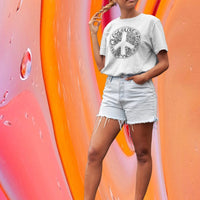Ever since their creation in 1920, T-shirts have remained among the most popular form of Women's and Men’s clothing. The reason is simple; they are durable, comfortable, and versatile.They come in different types to suit everyone: custom T-shirts, long sleeve T-shirts, short sleeve T-shirts and so much more. There are also T-shirts for men,T-shirts for womenT-shirtsfor kids.
Since T-shirts are so popular, it's not uncommon to wonder how exactly these exceptional pieces of clothing are manufactured. Wondering how your print T-shirts are made?
Let’s show you how!
What Materials are t-shirts made from?
Many T-shirts are made from 100% cotton and polyester or a mix of cotton and polyester. Natural dyes and organic cotton are also used by environmentally conscious producers. These materials make T-shirts highly comfortable and versatile wears.
- The Manufacturing Process
T-shirts are largely manufactured from specially designed machines that cut, assembles, and stitch in the best way possible. T-shirts seams are usually superimposed or narrow and are mostly seamed by positioning one fabric over the other and stitched with an over edge stitch.
· Styling
The T-shirt proportions are transmitted to patterns, and it is during the styling process manufacturers determine the size and T-shirt design.
· Cutting
During the cutting process, the t-shirts segments are fragmented according to the proportions of the patterns. In this section, the different parts of the t-shirts are cut to the manufacturer's taste. This could include the sleeves, pockets, front and back fractions, and many more.
· Attaching the front and back
When attaching the front and back of an untuned fabric, the front and back pieces are brought together and are stitched at both sides.
They are attached at the seam lines to create a narrow or superimposed seam and sewed together with an over edge stitch.
· Attaching the Sleeves
The fabric sleeves are usually completed before they are attached to the rest of the fabric.
An automated machine uses a conveyor to transport the garment's sleeves to the sewing head. Then the edges are completed by stitching or by using a band.
· Sewing the shoulder
The shoulder is stitched using a superimposed seam. However, some manufacturers make use of tape of an elastic.
· Connecting the Neck band
Round neck t-shirts circumference is usually shorter than the edge that has been stitched to the garment. It is therefore important to stretch the neckbands appropriately to connect them from sticking out. V-neck t-shirts neckband requires lapping by folding one side over the other for best results.
· Finishing the necklines
T-shirts necklines are usually tapped for comfort and durability.
· Adding the Labels
Manufacturers make use of labels to provide vital information about the fabric to the user. This includes the size, washing details, and type of fabric.
Wrap Up
The t-shirt manufacturing process is not as complicated as you might think, majorly because a large chunk of the process is automated.









0 comments